



Do you have a question about the Keysight Technologies FieldFox N9915A and is the answer not in the manual?
| Dynamic Range | > 100 dB |
|---|---|
| Measurement Types | Spectrum Analyzer, Vector Network Analyzer, Cable and Antenna Analyzer, Power Meter |
| Instantaneous Bandwidth | 40 MHz |
| Operating Temperature | -10°C to +50°C |
| Spectrum Analyzer Functionality | Yes |
| Vector Network Analyzer Functionality | Yes |
| Cable and Antenna Analyzer Functionality | Yes |
| Power Meter Functionality | Yes |
| Built-in GPS Receiver | Yes |
| Battery Life | Up to 4 hours |
| Weight | 3.6 kg |
| Amplitude Accuracy | 0.5 dB |
| Storage Temperature | -40 °C to +60 °C |
| Interface | USB, LAN |
| Display | 8.4 inch LCD |
Explains CAUTION and WARNING notices to alert users about potential hazards.
Explains how to turn the FieldFox on/off and switch to standby mode.
Describes features that prevent degradation from high internal temperatures.
Warns against applying excessive power or voltage, which can damage the FieldFox.
Covers settings for CAT mode, including measurement selection and quick settings.
Step-by-step guide on connecting, setting, and calibrating for return loss measurements.
Procedure for measuring cable loss using a 1-port reflection measurement.
Procedure for measuring insertion loss through a DUT or cable.
Step-by-step guide for performing DTF measurements.
Covers settings for DTF measurements, including the settings table and format.
Explains how to set the physical length of the DUT for DTF measurements.
Covers settings for TDR measurements, including format and settings table.
Explains how to set the physical length of the DUT for TDR measurements.
Details how to account for inherent cable loss and velocity factor in TDR measurements.
Covers settings for NA mode, including selecting mode and S-parameters.
Details how to convert active S-parameter trace to impedance, admittance, or 1/S-parameter.
Explains how to display multiple traces on the FieldFox screen in NA mode.
Allows viewing and changing most relevant settings from a single location in NA mode.
Details settings to reduce measurement noise and improve dynamic range in NA mode.
Covers settings for Time Domain analysis, including the Transform Settings table.
Describes the Gating function for virtually removing undesired responses in Time Domain.
Explains the systematic errors measured during calibration and when to perform a new one.
Provides instructions on how to perform a calibration using the FieldFox Connection Wizard.
Explains QuickCal, ideal for quick and simple calibration using jumper cables or adapters.
Describes mechanical calibration using discrete standards from a Cal Kit.
Details ECal as a complete solid-state calibration solution using electronic standards.
Explains how to verify calibration is good, especially when using jumper cables.
Covers settings for SA mode, including selecting mode and frequency range.
Lists available channel measurements in SA Mode: Channel Power, Occupied Bandwidth, ACPR.
Measures power of carrier channel and adjacent offset channels.
Provides steps for setting up EMF measurements using USB antenna and FieldFox options.
Reviews steps for setting up an EMF measurement, including importing antenna factors.
Explains how to make SEM measurements, comparing carrier and offset channel power levels.
Provides steps for selecting the SEM measurement in SA mode.
Covers settings for RTSA mode, including selecting mode and frequency range.
Explains how to set the frequency range for RTSA mode measurements.
Details how to check for compressed measurements by increasing RF Attenuation.
Describes drawing the most recent trace record at the bottom of the stack of previously-drawn traces.
Explains how to record RTSA trace sweeps and play them back at a later time.
Describes general purpose frequency domain and time domain measurements in IQA mode.
Covers settings for IQA mode, including selecting mode and making measurements.
Explains how to use the Measure menu for setting common parameters and views.
Provides procedure for saving I/Q data to a file, including file settings and device selection.
Explains how to use markers in I/Q Analyzer mode for spectrum and waveform measurements.
Explains that IQA mode requires amplitude, RF burst, and channel equalization alignments.
Reviews steps for setting up OTA measurements, including modifying settings and selecting display types.
Explains OTA capabilities for LTE FDD and 5GTF, including display types and data sorting.
Describes OTA mode support for LTE FDD and 5GTF standards, and measurement parameters.
Explains how to record OTA trace data and play them back, including screen annotation and data saving.
Explains how Option 360 enables measuring and displaying phased array antenna elevation and azimuth.
Reviews steps for setting up Option 360 measurements, including IP address and antenna settings.
Provides steps for connecting equipment and setting FieldFox to use static IP address.
Explains how to define measurements by selecting data display types and configuring settings.
Describes how to record phased array antenna trace data and play them back.
Explains how USB antennas enable measuring EMF for radio frequencies and supports OTA/SA modes.
Provides general steps for setting up a USB antenna measurement.
Reviews steps for selecting mode, connecting antenna, and importing factors.
Provides procedure to download Node.js and run FieldFox mapping software.
Details downloading and using the FieldFox Map Support Tool for map management.
Explains how to import *.zip files into the FieldFox for map data.
Reviews steps for setting up Option 352 Mapping measurement.
Provides steps for setting up indoor maps, including saving and importing pictures.
Provides steps for setting up outdoor maps, requiring GPS Option 307.
Explains how to enable data logging, set interval, and save results.
Describes how to record and play back GPS mapping data and overlay pointers on maps.
Provides an overview of the FieldFox Remote Server mode and connection process.
Describes the capabilities of 89600 VSA Software for signal evaluation and troubleshooting.
Explains how Spectrogram draws the most recent trace record for visual history.
Provides steps for recording SA trace sweeps and saving them to a session file.
Explains how to replay recorded SA trace sweeps and analyze the data.
Details settings for changing recording configuration, including interval and file settings.
Covers settings for Reflection Mode, including selecting mode, measurement, and normalization.
Covers settings for Built-in Power Meter Mode, including frequency, span, step, and attenuation.
Covers settings for USB Power Meter Mode, including selecting mode, average/peak, and zeroing.
Covers settings unique to FOPS, including selecting Power Meter, measurement selection, and sweep type.
Lists supported Keysight USB Peak Power Sensors for pulse measurements.
Details how trigger signals initiate pulse measurement acquisition.
Covers settings for VVM mode, including selecting mode, measurement, and frequency.
Explains how to set the output power level (High, Low, or Manual) in VVM mode.
Discusses CalReady accuracy and when to perform QuickCal or Mechanical Cal.
Describes using a 1-Port Cable Trimming measurement for validating proper electrical length.
Explains measuring electrical length, insertion loss, gain, or isolation of a DUT at a single CW frequency.
Explains ERTA uses two FieldFox units for long-distance scalar transmission measurements.
Lists requirements (two FieldFox units, cables) and limitations (removed SA features) for ERTA mode.
Guides user through physical setup, connecting cables, and testing partnership.
Details selecting measurement settings like Frequency range, Res BW, Points, and Zeros pan frequency.
Explains how to demodulate and characterize AM/FM signals using FieldFox's analog demodulation.
Explains how Channel Scanner enables measuring and displaying channel power vs. frequency.
Reviews steps for setting up a channel scan measurement.
Explains how Noise Figure mode uses Y-Factor technique to calculate noise figure.
Provides steps for defining a noise figure measurement.
Explains how Noise Figure mode calculates and displays measurement uncertainty.
Provides an example procedure for measuring devices using auto integration feature.
Explains how markers move along X-axis for numerical readout and search for Y-axis values.
Explains how marker searches move markers to trace locations exhibiting search criteria.
Describes limit lines as visual representations of specified limits for measurements.
Restores FieldFox measurement settings to a known condition (factory default or mode default).
Explains how to save current settings as preferences or restore factory default settings.
Describes how to erase all user-written data from the FieldFox.
Provides steps for running the FieldFox self-test.
Explains connecting FieldFox to PC via USB using Keysight IO Libraries for SCPI commands.
Explains how to save current settings and calibration to a file.
Explains how to copy or delete files stored in internal memory, SD card, or USB flash drive.
Explains using internal or external sources for accurate measurements.
Details configuring LAN settings for communication with Data Link Software.
Explains how to back up user data to a USB or SD card.
Provides steps on how to restore user files from a USB or SD card.
Provides instructions on charging the battery internally with AC/DC adapter or externally.
Lists general safety warnings for operating the FieldFox instrument.
Provides safety warnings related to the AC/DC adapter and its usage.
Lists critical safety warnings for handling lithium-ion batteries.
Provides guidance on safe handling, transportation, and disposal of batteries.
Provides precautions for handling static sensitive devices to prevent instrument damage.
Discusses calibration period based on requirements, performance drift, and connector wear.
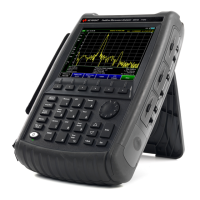



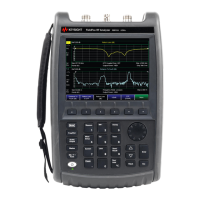


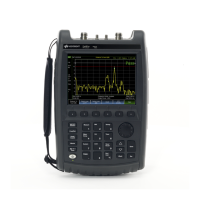
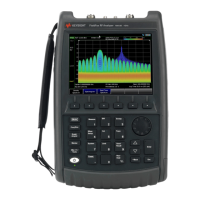
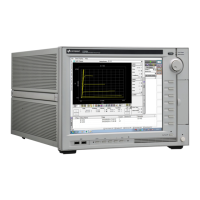


